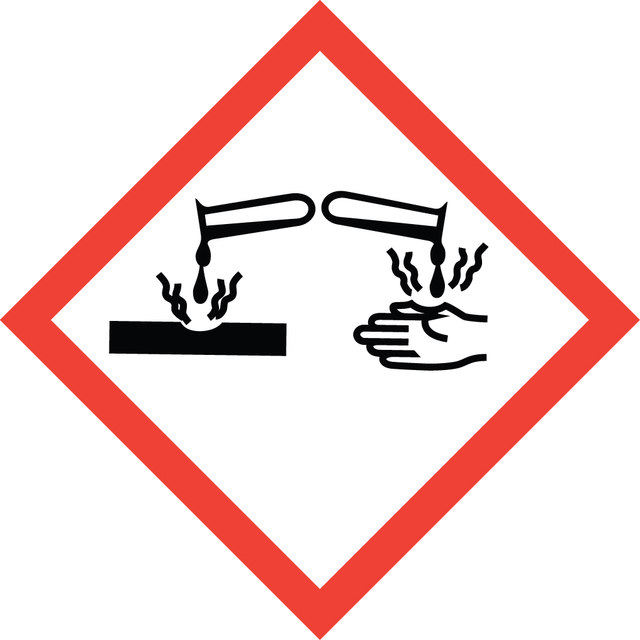Select a Size
About This Item
grade
reagent grade
Quality Level
vapor density
1.03 (vs air)
vapor pressure
<1.45 mmHg ( 25 °C)
form
crystalline
autoignition temp.
572 °F
expl. lim.
73 %
dilution
(for analytical testing)
mp
120-170 °C (lit.)
density
0.88 g/mL at 25 °C (lit.)
storage temp.
2-8°C
SMILES string
[O-]#[C+H2]
InChI
1S/CH2O/c1-2/h1H2
InChI key
WSFSSNUMVMOOMR-UHFFFAOYSA-N
Looking for similar products? Visit Product Comparison Guide
General description
Application
Paraformaldehyde has been used for fixing of cells and tissue sections during staining procedures.
Signal Word
Danger
Hazard Statements
Precautionary Statements
Hazard Classifications
Acute Tox. 4 Inhalation - Acute Tox. 4 Oral - Carc. 1B - Eye Dam. 1 - Flam. Sol. 2 - Muta. 2 - Skin Irrit. 2 - Skin Sens. 1 - STOT SE 3
Target Organs
Respiratory system
Storage Class Code
4.1B - Flammable solid hazardous materials
WGK
WGK 2
Flash Point(F)
Not applicable
Flash Point(C)
Not applicable
Personal Protective Equipment
Regulatory Information
Choose from one of the most recent versions:
Already Own This Product?
Find documentation for the products that you have recently purchased in the Document Library.
What is the difference between formaldehyde and paraformaldehyde?
Paraformaldehyde is the polymeric form of formaldehyde. Paraformaldehyde is a solid, and formaldehyde is a gas. Formaldehyde solutions consist of formaldehyde gas dissolved in a solvent of some kind.
What is the shelf life of Product P6148, Paraformaldehyde?
The shelf life has not been assigned but guarantee of quality is 1 year from the time of receipt for unopened bottles stored at 2-8 °C. We expect the product to be of good quality for at least 2 years.
How does Product P6148, Paraformaldehyde, compare to prilled paraformaldehyde, Product 441244?
Prilled has the appearance of small white beads. Product P6148 is a powder, not prilled.
How stable are Product P6148, Paraformaldehyde, solutions?
Buffered solutions of 2-4% can be stored protected from light for 2-3 weeks at 2-8°C.
How to prepare solutions of Product P6148, Paraformaldehyde?
Paraformaldehyde does not dissolve but rather can be depolymerized in solution. Depolymerized solutions can be prepared in water with heating to 55-60°C. If necessary, further addition of 1-2 drops of a sodium hydroxide solution may be required. Some protocols suggest that paraformaldehyde should be prepared in buffered solutions such as phosphate buffer or PBS at approximately pH 7.
Which document(s) contains shelf-life or expiration date information for a given product?
If available for a given product, the recommended re-test date or the expiration date can be found on the Certificate of Analysis.
How do I get lot-specific information or a Certificate of Analysis?
The lot specific COA document can be found by entering the lot number above under the "Documents" section.
What is the difference between formaldehyde and paraformaldehyde?
Paraformaldehyde is the polymeric form of formaldehyde. It is a solid. Formaldehyde is a gas which when dissolved in water gives a formaldehyde solution. Commercially available formaldehyde solutions usually contain 10-15% methanol, which prevents the formaldehyde from forming the polymeric paraformaldehyde.
How do I find price and availability?
There are several ways to find pricing and availability for our products. Once you log onto our website, you will find the price and availability displayed on the product detail page. You can contact any of our Customer Sales and Service offices to receive a quote. USA customers: 1-800-325-3010 or view local office numbers.
What is the Department of Transportation shipping information for this product?
Transportation information can be found in Section 14 of the product's (M)SDS.To access the shipping information for this material, use the link on the product detail page for the product.
What are the differences between the Paraformaldheyde products and which is best suited for use as a fixative for Electron Microscopy?
Product 16005 is sold only in Europe and is not available to US customers.The primary differences among the various products is in the form for each product. P6148 is listed as crystalline, 158127 is listed as powder, and 441244 is listed as prilled. The product information page for 441244 states the prilled form will go into solution more readily, but the prilled, crystalline, and powder forms are equivalent in terms on use. The prilled form is expected to slow down the rate of sublimation compared to the powder or the crystalline forms. Any of the 3 products should be suitable for use as a fixative. However, once prepared, paraformaldehyde solutions are unstable unless methanol is added as a stabilizer. Customer options vary from preparing solutions daily to storing solutions for 2 or 3 weeks. If used as a fixative for electron microscopy, we recommend preparing solutions fresh daily to avoid the risk of repeating tedious EM work due to deterioration of the fixative. For less critical applications, it would be more acceptable to use solutions stored for longer periods of time.
My question is not addressed here, how can I contact Technical Service for assistance?
Ask a Scientist here.
Articles
Available Fluorescent in situ hybridization (FISH) procedures, reagents and equipment.
可用的荧光原位杂交(FISH)过程、试剂和设备。
Protocols
Cell staining can be divided into four steps: cell preparation, fixation, application of antibody, and evaluation.
细胞染色可分为四个步骤:细胞制备、固定、抗体孵育和评估。
Related Content
Three-dimensional (3D) printing of biological tissue is rapidly becoming an integral part of tissue engineering.
Our team of scientists has experience in all areas of research including Life Science, Material Science, Chemical Synthesis, Chromatography, Analytical and many others.
Contact Technical Service


